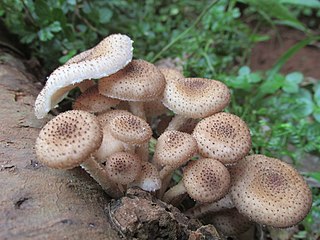
Phytophthora is a genus of plant-damaging oomycetes, whose member species are capable of causing enormous economic losses on crops worldwide, as well as environmental damage in natural ecosystems. The cell wall of Phytophthora is made up of cellulose. The genus was first described by Heinrich Anton de Bary in 1875. Approximately 210 species have been described, although 100–500 undiscovered Phytophthora species are estimated to exist.

Pinus cembra, also known as Swiss pine, Swiss stone pine, Arolla pine, Austrian stone pine, or just stone pine, is a species of pine tree in the subgenus Strobus.

The University of Delaware Botanic Gardens are botanical gardens and an arboretum located on the campus of the University of Delaware, in Newark, Delaware, United States. The gardens are open to the public without charge.

The Donald E. Davis Arboretum, in Auburn, Alabama, United States, is a public native plants museum, and botanical arboretum with educational facilities, event spaces, and a conservation program. Its grounds, covering 13.5 acres of Auburn University's campus, include cataloged living collections of associated tree and plant communities representative of Alabama's ecosystems, among which is mixed oak forest, carnivorous bog, and longleaf pine savanna. The living collections include more than 1,000 plant types, including 500 different plant species, with over 3,000 cataloged specimens. The Arboretum contains over a mile (2 km) of interwoven walking trails that meander through various southeastern biotopes.
Phaeosphaeria herpotrichoides is a fungal plant pathogen that infects the commercial crops rye and wheat.

Coleosporium tussilaginis is a species of rust fungus in the family Coleosporiaceae. It is a plant pathogen.
Davidiella tassiana is a fungal plant pathogen infecting several hosts, including Iris barnumiae subsp. demawendica in Iran.

Peronospora potentillae is a plant pathogen infecting strawberries. It also infects Alchemilla filicaulis.
Peronospora viciae is a plant pathogen. It is a downy mildew that can infect pea plants. In Iceland it grows on wild Vicia cracca and Lathyrus species.

Puccinia campanulae is a plant pathogen that causes rust on bellflower (Campanula).

Puccinia dioicae is a plant pathogen that causes rust on goldenrod.
Phoma herbarum is a fungal plant pathogen infecting various plant species, including Alchemilla vulgaris, Arabis petraea, Arenaria norvegica, Armeria maritima, Bartsia alpina, Capsella bursa-pastoris, Erysimum, Euphrasia frigida, Honckenya peploides, Matricaria maritima, Rumex longifolius, Thymus praecox and Urtica dioica.

Armillaria fuscipes is a plant pathogen that causes Armillaria root rot on Pinus, coffee plants, tea and various hardwood trees. It is common in South Africa. The mycelium of the fungus is bioluminescent.
Wilcoxina is a genus of fungi in the family Pyronemataceae. Species are cosmopolitan in distribution, and have been found growing with host plants in a wide variety on environments, such as nursery soils with high pH, mining sites with low pH and heavy metal contamination, natural forests and plantations, urban areas and peat soils. Wilcoxina species are mycorrhizal, and commonly infect a variety of conifers and deciduous trees such as Pinus, Betula, and Quercus. Some species have been shown to produce the siderophore compound ferricrocin. Wilcoxina was circumscribed by Chin Yang and Richard Korf in 1985.

Lophodermium is a genus of fungi within the family Rhytismataceae. The genus contains 145 species and has a global distribution. Species of this genus are usually observed producing zone lines, conidiomata and ascomata on dead fallen leaves, but at least some are known to colonize living leaves. In many cases they then live inside the colonized leaf as a symptomless endobiont, where they are regarded as detritivores utilising dead plant matter. In a few cases they may kill all or part of the leaf prematurely, and there is a substantial literature dealing with those species as plant pathogens. The genus infects many different plant families but with a notable concentration in the family Pinaceae; many Lophodermium species are restricted to a single host genus, but some, particularly those infecting grasses, may infect several genera. Some are economically important plant pathogens, such as those that cause needlecast disease in European Black Pine, Scots Pine and Red Pine in forestry and christmas tree plantations. In these species, notably L. pinastri and L. seditiosum, the fungal spores disperse and infect the pine needles in late summer, which turn brown by the following spring and then fall off.
Phycomelaina is a genus of fungi in the family Phyllachoraceae. This is a monotypic genus, containing the single species Phycomelaina laminariae.
Amalgaviridae is a family of double-stranded RNA viruses. Member viruses infect plants and are transmitted vertically via seeds. The name derives from amalgam which refers to amalgaviruses possessing characteristics of both partitiviruses and totiviruses. There are ten species in the family.
Phytophthora pluvialis is a semi-papillate plant pathogen that mainly infects tanoak-Douglas-fir forests of western Oregon. It was reported in Cornwall. UK, in October 2021; the first record for Europe.

Stereocaulon paschale is a species of lichen belonging to the family Stereocaulaceae.
Delphinella polyspora is a species of fungus in the family Dothioraceae. It is known to grow on the pedicels and fruit of Kalmia procumbens and on Rhododendron indicum.










